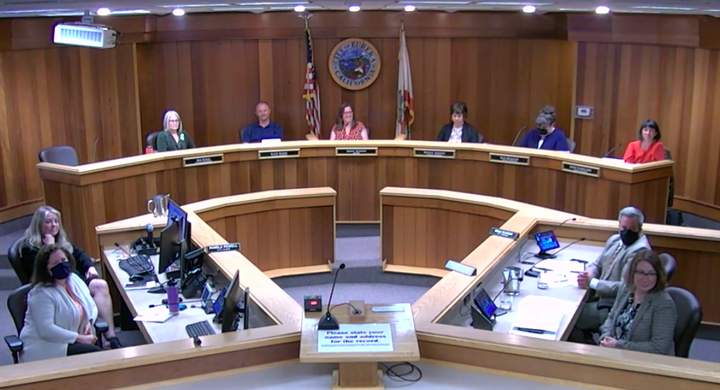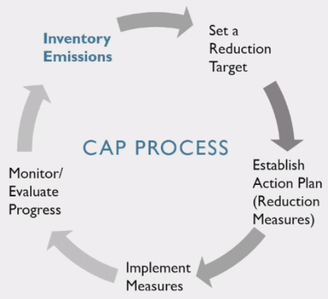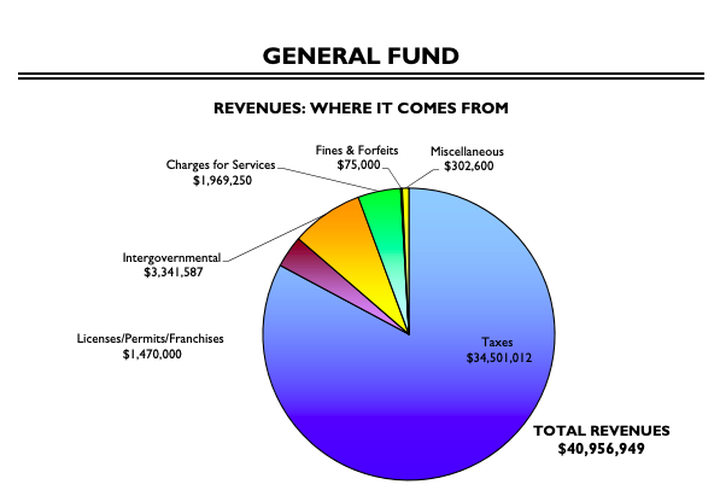Screenshot of Tuesday’s Eureka City Council meeting.
###
Film Commission Funding Request
In anticipation of two major studio film productions coming to Humboldt County this year, the Humboldt-Del Norte Film Commission asked the Eureka City Council for an additional $10,000 in funding to support its small staff in hosting and production efforts.
“We found out that they’ve got a lot of work coming up – [including] two very large productions coming into the area – and are looking for some additional financial support,” Eureka City Manager Miles Slattery explained during Tuesday’s meeting. “As the council is aware, we have a funding agreement with the film commission, amongst other agencies here locally, that gets approved on an annual basis.”
Mayor Susan Seaman asked how much money the two productions are anticipated to bring into the community. Film Commissioner Cassandra Hesseltine said one of the productions is projected to bring in approximately $20 million in six months – more than the last decade of films combined.
“I’ve been working on both films for three years pre-pandemic and now they both have told us that they have the green light to come,” Hesseltine said. “…They both were actually in town two weeks ago scouting. …I was told two years ago by the line producer [that the first one] would be bringing in approximately $20 million. That’s direct dollars in six months. The film commission has only done $12 million in 11 years, to put that it in perspective.”
Approximately three-quarters of the second film would be shot in Humboldt County, she said, noting that it’s “actually been written for Eureka specifically.”
“I can’t tell you the name of any of his movies because [you would figure out] who he was but he’s big,” she said. “He’s writing the whole movie around the locations here. It would be a considerable amount of money.”
The film commission lost some funding last year as a result of the pandemic, and although funding is starting to pick back up, there’s too much to do for a staff of two. “We’re starting to turn down a lot of things,” she said. “It’s come to that point where it’s really great but it’s too much because it’s all happening at the same time. …We really need a part-time or full-time person in our office. …We’ve had to use our reserves and it’s been stressful to keep up where we are.”
In addition to the $25,000 the City provides annually, the film commission receives approximately $100,000 from the county, up to $15,000 from Del Norte County, roughly $4,300 from the City of Arcata, $4,000 from the Fortuna Chamber of Commerce and typically $60,000 from the Humboldt Lodging Alliance (HLA).
“This $10,000 would be supplementing an additional position,” Hesseltine said. “That’s the goal if we can get enough money between all of our funders.”
The council ultimately voted to unanimously approve the funding request.
Arts Alive Street Closure
The council also reviewed survey results from Old Town business owners regarding special event street closures. The City decided to take a walk on the wild side and implement a trial street closure during Arts Alive earlier this month, a move that was criticized by a handful of local business owners and Eureka Main Street’s Board of Directors, who said the closures impacted parking accessibility and business revenue.
The council decided to give the street closure a whirl during a meeting last month. The Eureka Main Street Board of Directors sent a letter of opposition to the council shortly thereafter, asking the City to reconsider and citing fears that the closure would “greatly limit accessibility for employees, customers, and residents to reach businesses or their homes with reasonable ease.” The City went ahead with the closure but agreed to survey local businesses within the closure area as a part of the trial run.
“There was a question that asked whether or not the foot traffic within their business was increased or not and 57 percent of the respondents said that there was an increase or no change in the footpath the traffic within their business and 24 percent of the respondents stated that there was a decrease in foot traffic,” City Manager Miles Slattery said. “The remainders were businesses that weren’t open, businesses that weren’t available or that they closed prior to the Arts Alive going on.”
Businesses were also asked whether their sales were impacted by the street closure. Sixty-two percent of businesses surveyed reported an increase or no change in revenue whereas 19 percent reported a decrease. The remainder of businesses surveyed were either not open or not available to be surveyed.
Businesses were also asked whether they supported the street closure. Fifty-four percent said they were in support of or indifferent to the closure, 21 percent did not support it and 12 percent said they would have preferred a different footprint for the closure.
Slattery said the folks who came out for Arts Alive expressed “overwhelming support for the street closures.” He said the City will continue the street closures for the foreseeable future, but added that staff will work with local business owners to address their concerns surrounding parking and communications.
Speaking from a safety standpoint, Interim Eureka Police Chief Todd Jarvis spoke in favor of the closure, noting that he had “concerns about the amount of traffic on the sidewalks being forced into the street” during previous events in Old Town.
“We talked about trying this test closure and I felt that was very successful,” he said. “…There were a few things we’re going to tune up as far as some of the gaps and some of the openings we left with the thought to let people [move their vehicles].
Next time, the City will provide more notice (at least 24 hours) to businesses and people parked within the closure area, said Eureka Public Works Director Brian Gerving.
The concrete blocks used for the closure were criticized by Eureka Main Street for not being “visually attractive.” Gerving said the concrete barriers would serve as a temporary method of blocking the road and invited local artists to beautify the blocks in the meantime.
“We’re looking at getting vehicle-rated bollards,” he said. “We’re in the process of nailing down bids for the materials and then working on quotes for the installation of those bollards at various locations in both Old Town and Henderson Center. …We probably won’t see those before next year, so in the meantime, we think the concrete blocks are a viable option.”
Councilmember Kim Bergel asked if the planters used to close E Street for Friday Night Market could be used instead of the concrete blocks. Gerving said they could be used for part of the closure but said staff has to use different equipment to move the planters versus the concrete barriers.
Councilmember Kati Moulton conducted her own anecdotal survey during Arts Alive and said people loved the closure because it provided a street festival feel.
“I talked to a few business owners who said they definitely saw more people coming in and talked to somebody with an art gallery who was really excited about the street closures and the potential for using the sidewalk space to basically spill her out in front and draw more people,” she said. “I think that’s an approach that a lot of businesses take advantage of.”
Councilmember Natalie Arroyo said she had a blast skating down Second Street during Arts Alive and said she received overwhelmingly positive feedback.
The council did not take any action on the item.
Climate Action Plan
The council also received an overview of the draft Humboldt Regional Climate Action Plan (CAP). Since 2019, the county’s seven incorporated cities have worked with the county and the Redwood Coast Energy Authority (RCEA) to develop a CAP to reduce local greenhouse gas emissions and build resilience to climate-related hazards. The 45-day public review period for the state-mandated document will end next month.
“The purpose of the short review period is to gauge whether there are any fatal flaws or whether we are ready to move on to the next phase,” Cristin Kenyon, Principal Planner for the City, explained. “The environmental review phase could take up to one year. During that phase, an Environmental Impact Report, or EIR, is going to be prepared under the California Environmental Quality Act (CEQA) for the CAP.”
The draft CAP outlines strategies to be implemented to reduce regional greenhouse gas emissions to 40% below 1990 levels by 2030 and make progress toward California’s goal of zero net emissions by 2045. While the draft CAP includes specific measure targets, it is less specific about how jurisdictions will achieve these targets, Kenyon said.
“Most of the qualified measures that are in the draft cap are focused on transportation and land use, energy usage and buildings as well as solid waste production,” she said. “…The CAP also has a bunch of measures that are not quantified but are supporting measures that are helping us reach our quantified targets. This includes a whole chapter of advisory measures on biological carbon sequestration. ….Something I learned from the CAP was that wetlands store more carbon per acre than forests. So wetland restoration is really important.”
Michael Richardson, a supervising planner for the County of Humboldt, noted that the CAP can be tweaked in the future “but it needs to be close enough that it is relevant to the EIR.”
Councilmember Scott Bauer thanked City and county staff for their efforts on the CAP but underscored the importance of getting the document finalized as soon as possible.
“I’m not wanting to sound, you know, doom and gloom, but we have limited time,” he said. “As a scientist, this is all we talk about. My question is, can we get it done faster? …I guess we can start implementing but having the [EIR] done is a really crucial component. What do you think?”
Because the CAP has minimal environmental impacts and is projected to actually have a positive impact on the environment, Richardson said the EIR “could write itself in a lot of ways and that will speed up the process.”
During public comment, Will Zerlang of Zerlang’s Construction expressed his support for the CAP but raised concern about how it would impact local builders.
“I’m all for environmental building, but to implement electrifying a home in the next five years in Humboldt County, it’s not even feasible,” he said. “…The cost to people building homes and homeowners is going to be significant. …I’m required to put solar panels on my homes and as many electrical heating systems as I possibly can. …Hot water heaters currently are not even up to speed in the United States to fully function more efficiently than a gas hot water heater. The technology is not even quite there yet.”
Local environmental attorney Paul Hagen called on the City and the county to take immediate action to mitigate the impacts of climate change.
“I believe in local government very much and this [CAP] is very significant,” he said. “…You really got a lot of options to change things for the future here in your city and in your county. …We have an enormous offshore wind component coming in off the county here within the next few years, we’ve got a lot of other things going on and time is not on our side.”
The council did not take any action on the item.
The draft CAP can be found here.
Fiscal Year 2022-23 Budget Proposal
It’s that time of the year again! The council took its first look at the city’s draft budget proposal for Fiscal Year (FY) 2022-23. After two years of significant budget cuts, the upcoming fiscal year is “pretty boring” in comparison to the last two years, according to Eureka Finance Director Lane Millar.
The City will experience virtually no change in its General Fund budget, which projects nearly $41 million in revenue for FY 22-23.
Screenshot
“This year, there are no cuts,” Millar said. “…Before COVID, we were looking at roughly a 1% increase year over year [in General Fund revenue]. This is not surprising. There are some things that are going down, such as intergovernmental [revenue] that represents a lot of grant reimbursements. Those fluctuate year to year and that’s normal to see.”
Following a brief presentation on the budget proposal, Councilmember Scott Bauer asked Millar if the budget could be impacted by instability in the global economy. “Do we anticipate any potential dark skies in the future for our budget?”
”The state is vulnerable because I believe they capture capital gains taxes, which are going to take a huge hit based on what’s going on in the market,” Millar said. “For us, there is a chance that you will see the consumer start to back off goods and go and spend their money towards services. That’s kind of what happened during the pandemic….And then you add on the effects of inflation, which tend to push people away from buying goods. I wouldn’t be surprised if we see a slight downturn in sales tax revenue.”
Even still, he emphasized that the City’s budget would be able to “withstand some bad years moving forward.”
Millar spared the council many of the nitty-gritty details of the budget since it was the council’s first look at the proposal. There will be at least two additional presentations on the proposal before it is adopted, including a budget study session during the council’s next special meeting on Tuesday, May 24 at 5:30 p.m.
A recording of Tuesday’s meeting can be found here.




CLICK TO MANAGE